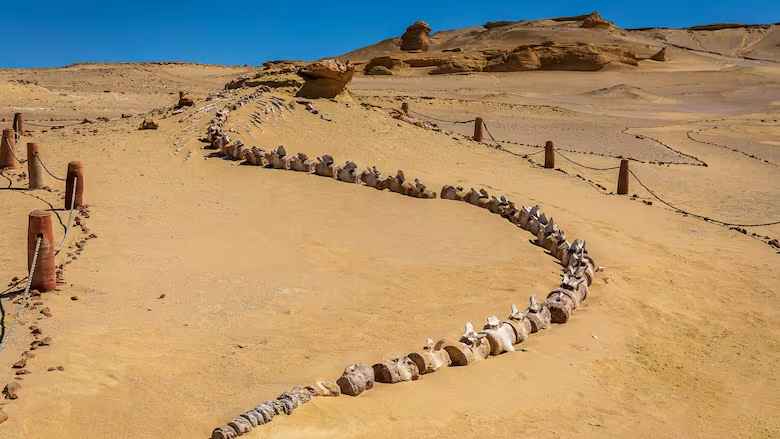The Evolutionary Mystery of Wadi Al-Hitan
Nestled deep within the vast expanse of Egypt’s Sahara Desert lies a remarkable location known as Wadi Al-Hitan, or Whale Valley. This site has become a crucial piece of evidence in understanding one of the most intriguing chapters of evolutionary history—the transformation of whales from land-dwelling creatures to oceanic giants. Fossils found here reveal that ancient whales once possessed feet and toes, offering a glimpse into their past when they roamed on land.
Wadi Al-Hitan is home to over 400 fossilized whale skeletons, each providing a unique insight into the evolution of these marine mammals. These remains date back to the late Eocene epoch, approximately 55 to 34 million years ago, a time when the region was submerged beneath the Tethys Ocean. UNESCO recognizes this site for its exceptional value in showcasing the evolutionary journey of whales, from terrestrial animals to fully aquatic beings.
The first significant discovery at Whale Valley took place in 1902, when paleontologists uncovered the remains of Basilosaurus isis, a formidable predator that could grow up to 60 feet long. This species was a top predator of its time, using its sharp teeth and elongated snout to crush the skulls of smaller whales before consuming them. This finding provided early clues about the predatory nature of ancient whales.
In 1989, a groundbreaking discovery was made: fossils of B. isis with preserved feet, toes, and hind limbs. This rare find confirmed that whales once walked on land, a fact that contradicted earlier assumptions about their anatomy. Although modern whales do not have external legs, they still possess pelvic bones, which serve as a genetic link to their land-based ancestors.
The significance of Wadi Al-Hitan was further recognized in 2005 when UNESCO designated it a World Heritage Site. This recognition highlighted the site’s importance in the study of paleontology and evolutionary biology. Since then, researchers have uncovered additional marine fossils, including ancient sharks, turtles, sea cows, rays, and crocodiles, all preserved in the arid desert climate for millions of years.
Today, Wadi Al-Hitan functions as an open-air museum, attracting scientists, researchers, and visitors who are eager to explore its rich fossil record. The site continues to be a hub for ongoing research, with strict protections in place to ensure the preservation of its invaluable scientific heritage.
As new discoveries continue to emerge, Wadi Al-Hitan remains a critical location for understanding the complex process of evolution. It serves as a testament to the dynamic changes that have shaped life on Earth, offering a rare and fascinating window into the past. For those interested in the origins of marine life, this site stands as a powerful reminder of how the natural world has continually adapted and transformed over millions of years.







